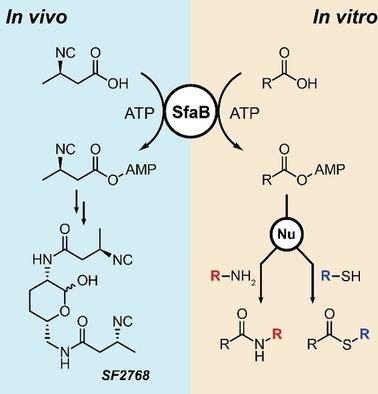当前位置:
X-MOL 学术
›
Angew. Chem. Int. Ed.
›
论文详情
Our official English website, www.x-mol.net, welcomes your
feedback! (Note: you will need to create a separate account there.)
Repurposing the 3‐Isocyanobutanoic Acid Adenylation Enzyme SfaB for Versatile Amidation and Thioesterification
Angewandte Chemie International Edition ( IF 16.1 ) Pub Date : 2020-10-07 , DOI: 10.1002/anie.202010042 Mengyi Zhu 1 , Lijuan Wang 2 , Jing He 3
Angewandte Chemie International Edition ( IF 16.1 ) Pub Date : 2020-10-07 , DOI: 10.1002/anie.202010042 Mengyi Zhu 1 , Lijuan Wang 2 , Jing He 3
Affiliation

|
Genome mining of microbial natural products enables chemists not only to discover the bioactive molecules with novel skeletons, but also to identify the enzymes that catalyze diverse chemical reactions. Exploring the substrate promiscuity and catalytic mechanism of those biosynthetic enzymes facilitates the development of potential biocatalysts. SfaB is an acyl adenylate‐forming enzyme that adenylates a unique building block, 3‐isocyanobutanoic acid, in the biosynthetic pathway of the diisonitrile natural product SF2768 produced by Streptomyces thioluteus, and this AMP‐ligase was demonstrated to accept a broad range of short‐chain fatty acids (SCFAs). Herein, we repurpose SfaB to catalyze amidation or thioesterification between those SCFAs and various amine or thiol nucleophiles, thereby providing an alternative enzymatic approach to prepare the corresponding amides and thioesters in vitro.
中文翻译:

重新利用3-异氰基丁酸腺苷酸化酶SfaB进行多功能酰胺化和硫酯化
微生物天然产物的基因组挖掘使化学家不仅能够发现具有新颖骨架的生物活性分子,而且能够识别催化多种化学反应的酶。探索这些生物合成酶的底物混杂性和催化机理有助于开发潜在的生物催化剂。SfaB是一种形成酰基腺苷酸的酶,可在由硫链霉菌产生的二异腈自然产物SF2768的生物合成途径中,对独特的结构单元3-异氰基丁酸进行腺苷酸化。,并且该AMP连接酶被证明可以接受各种短链脂肪酸(SCFA)。在本文中,我们将SfaB重新用于催化那些SCFA与各种胺或硫醇亲核试剂之间的酰胺化或硫酯化反应,从而提供了另一种酶促方法来体外制备相应的酰胺和硫酯。
更新日期:2020-10-07
中文翻译:

重新利用3-异氰基丁酸腺苷酸化酶SfaB进行多功能酰胺化和硫酯化
微生物天然产物的基因组挖掘使化学家不仅能够发现具有新颖骨架的生物活性分子,而且能够识别催化多种化学反应的酶。探索这些生物合成酶的底物混杂性和催化机理有助于开发潜在的生物催化剂。SfaB是一种形成酰基腺苷酸的酶,可在由硫链霉菌产生的二异腈自然产物SF2768的生物合成途径中,对独特的结构单元3-异氰基丁酸进行腺苷酸化。,并且该AMP连接酶被证明可以接受各种短链脂肪酸(SCFA)。在本文中,我们将SfaB重新用于催化那些SCFA与各种胺或硫醇亲核试剂之间的酰胺化或硫酯化反应,从而提供了另一种酶促方法来体外制备相应的酰胺和硫酯。











































 京公网安备 11010802027423号
京公网安备 11010802027423号